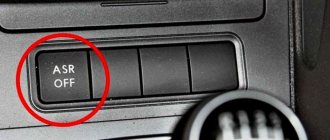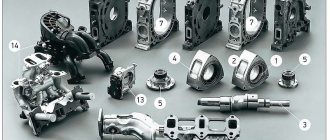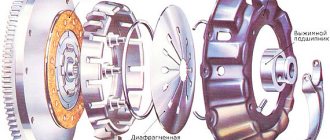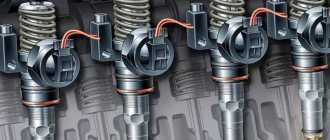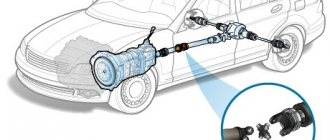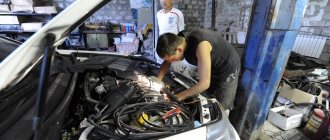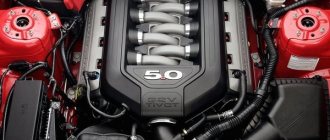One of the problems facing automotive engineers is steering lightness. For a long time this problem was solved in one way; The diameter of the steering wheel increased and the drive ratio increased. This method made it possible to operate even heavy trucks with ease. At the same time, the engineers did not impose any requirements for comfort. Therefore, the driver had to make 5-6 turns with the huge steering wheel, which was extremely inconvenient. However, modern experts have found a more elegant solution to the problem - electric power steering.
Purpose and advantage
In technical documents, the electric power steering wheel is designated as ESP. The translation of this abbreviation from English means “electric power steering”. It is an alternative to hydraulic booster. The main purpose of the electric amplifier is to reduce the effort exerted by the motorist on the steering wheel while driving the car.
The electric amplifier itself is a high-tech unit that operates on the basis of electronics. This means that hydraulics are completely excluded from the process. This device is rapidly gaining popularity among car enthusiasts and car manufacturers. Unlike the hydraulic booster, it has a lower production cost. In addition, such an element is easier to maintain and breaks less often. The electric amplifier is controlled using various sensors. They analyze the received data and transmit them in the form of signals to the mechanisms that are responsible for turning the wheels. Electric amplifiers are improved every year. Manufacturers make improvements to them, reducing the number of possible malfunctions. The main advantages of the electric booster over the hydraulic mechanism:
- reliability;
- environmental friendliness and technical safety;
- the ability to drive a vehicle in automatic mode;
- silent operation;
- simple maintenance;
- easy and smooth control of the machine;
- the ability to drive a car if the ESD fails;
- ensuring consistency between rotation angles and proportionality between resistance forces.
Mechanism design
According to its structural principle, the EUR is radically different from the classical mechanism. The design of the electric amplifier directly depends on the manufacturer. The most common option consists of an electric motor on the steering column, a mechanical transmission and a control system based on an electrical unit. Each detail has its own important role.
Electrical engine
The electric motor is usually an asynchronous electric motor. This is what sets the EUR in motion. There are several electric motor layouts:
- the electric motor transmits force to the steering shaft;
- the electric unit acts on the steering rack.
In the first case, the electric amplifier is built directly into the steering column. The electric motor transmits torque to the steering shaft using a mechanical transmission. However, the second option is the most popular and in demand. It is also called EMUR or electromechanical power steering. Structurally, it can consist of two gears or an amplifier with a parallel drive. The first mechanism transmits torque using one of the gears. On the second, the torque is transmitted via an electric motor. The parallel drive amplifier transmits power through a belt drive or ball screw nut.
Gearbox
A gearbox is a mechanical transmission that consists of a gear and a worm element. The shape of the device may vary depending on the specific car model, as well as the engineering capabilities of the manufacturer. The gearbox is necessary to convert the force of turning the steering wheel to the steering rack or from the steering wheel to the electric motor. The connection of parts, as a rule, occurs at an angle of ninety degrees.
Structure of the structure
There are many options for the structure of an electric amplifier, so for clarity, let’s look at the products of the leader in this production, represented by the ZF company - an electric amplifier of the Servolectric brand. The EUR is selected and “installed” taking into account the specific type of car. On miniature passenger cars, the electric power amplifier is placed on the steering shaft; among second-class cars, the transmission of auxiliary power occurs through an installed gear, and in the case of light commercial vehicles and SUVs, the use of a parallel-axle design is noted.
Since passenger cars do not require a large impact from the EUR, the servo drive and electric motor are installed on such cars so miniature that all the equipment can be easily placed under the steering wheel in the car interior itself. At the same time, all sensors are also located there. This arrangement is very successful even because the entire structure is qualitatively protected from exposure to high temperatures and contamination.
Mid-size cars are equipped with an electric booster with a pair of gears. Through one of them, the rack receives power from the steering wheel, and through the second, additional power from the electric motor.
In order to create greater reinforcement, a parallel-axis design is used. Here, to impart linear movement to the roller rack, a gear-belt drive and a special mechanism are used.
Regardless of which design principle is used, in the event of a malfunction, the driver will be able to continue to drive his vehicle safely, thanks to the presence of direct mechanical contact between the wheel and the steering wheel.
Control system
The electronic amplifier control system includes:
- input sensors;
- electronic control unit;
- executive device.
Input sensors, in turn, are divided into:
- steering wheel torque sensor;
- steering angle sensor.
In addition, the amplifier control system uses information that is transmitted from the ABS control unit (wheel speed sensors) and from the powertrain control unit (crankshaft speed sensor). The device processes the received data and gives commands to the head mechanism.
Principle of operation
In terms of its operating principle, the electronic amplifier is somewhat reminiscent of the classic version, but with the addition of electronics. At the beginning of the process, the driver needs to turn the steering wheel left or right. At this time, the torsion shaft is twisted, and on the reverse side it moves. The sensors present in the mechanism read all the information and transmit it to the computer. The electronic unit analyzes this data and compares it with the performance of other sensors. As a result, the ECU calculates the force for the electric motor that must be applied to make the steering wheel turn easier.
The electric motor, in turn, after receiving a command from the ECU, begins to influence the steering rack or shaft (depending on the type of ESP). The processing speed directly depends on the current strength. The larger the latter, the more the mechanism rotates, and vice versa. In addition to the standard operating situation of the EUR, other modes can be tested, namely:
- the car takes a turn at high speed;
- turning is carried out at low speeds;
- maintaining the wheels in the main position (centered);
- return of wheels from extreme to middle position;
- other variations at medium speed.
Classic power steering
Classic power steering is still installed on many cars.
In addition to the presence of an expansion tank under the hood, it is immediately revealed by the appearance of the rack with hydraulic circuits. Classic power steering is still installed on many cars. In addition to the presence of an expansion tank under the hood, it is immediately revealed by the appearance of the rack with hydraulic circuits.
Advantages and disadvantages
An electronic amplifier, like any mechanism, is not without flaws. However, it has much more advantages. Among them are:
- fuel efficiency (due to the lack of load on the power unit, no additional fuel is wasted);
- reliability (no hydraulics, no leaks or leakage of oil);
- ease of maintenance;
- compact overall dimensions;
- vibration from the tires is not transmitted to the steering wheel;
- good interaction between the driver and the device;
- it is possible to adjust the characteristics independently;
- implementation of other driving assistants.
As for the disadvantages of the mechanism, they are as follows:
- there is no possibility to use ESD on trucks (Volvo is currently actively working on creating a similar mechanism, but it has not yet entered production);
- it is equipped only with expensive cars or flagship modifications of vehicles due to their high cost;
- poor protection against moisture.
It is worth noting that the main difference between the EUR and classical hydraulics and at the same time its main advantage is the possibility of implementing additional safety systems. For example, the car can be additionally equipped with an autopilot, auto parking and lane keeping systems, a steering mechanism and other services.
Major breakdowns
The electric power steering wheel cannot be called an ideal mechanism. Sooner or later, like other devices, it will require repair. The surest sign that the mechanism needs attention is the appearance of a corresponding icon on the dashboard. The indicator shows a steering wheel and an exclamation mark. In some models, the ESP inscription simply lights up, but this does not change the essence. According to statistics, sensors are the first to be replaced. Most often, the steering wheel rotation and torque sensors fail. The electric motor, through which the main control of the mechanism is carried out, may also break down. Another possible malfunction is failure of the electronic disk. It is usually installed in more modern vehicles. Due to the electronic disk, the angle of rotation of the steering wheel is read, as well as the sharpness and force applied by the driver.
The most reliable element is the ECU. The fact is that another backup unit is installed in the electrical unit, which will begin to function if the first one fails. We can conclude that moving mechanisms are most susceptible to breakdowns. However, ESDs are constantly being improved by manufacturers who try to reduce the possibility of breakdowns to a minimum. So, in many modern cars, the electric booster can work on sensors of other security systems and read information from their control units.
Author: P. Afanasyev
Repair of the electric booster on a Priora, replacement of the EUR
So, you need to replace the electric booster on the Priora or simply check the condition of its contacts. In any case, repair involves complete removal of the unit. Prepare the necessary tools:
- Chisel and hammer.
- Deep head for 8 and 13.
- Extension and ratchet, alternatively you can use a wrench.
It’s quite easy to remove the amplifier itself with your own hands, but in order to get to its mounts and the control unit, you will need to remove many parts of the dashboard: the steering wheel along with the airbag, the casing and the ignition switch. Once these components are removed, repairs to the amplifier can begin.
